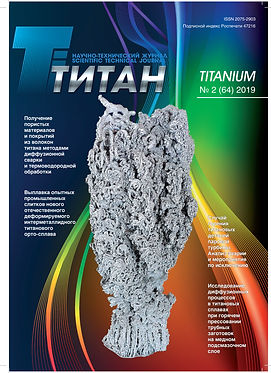
Interstate association
Titan №2 2019

Materials science
EFFECT OF CHEMICAL COMPOSITION AND HEAT TREATMENT ON STRUCTURE, MECHANICAL PROPERTIES AND MACHINING OF VST2K TITANIUM ALLOY
S.V. Skvortsova, G.V. Gurtovaya, A.V. Ovchinnikov, V.S. Spektor, A.P. Neiman
The article shows the possibility of creating a single-type structure by heat treatment and, accordingly, a close level of properties in hot-rolled semi-finished products of VST2K alloy of different chemical composition. The influence of chemical composition and structure of the VSТ2К alloy on the cutting force and temperature in the cutting zone during milling is studied. The optimal structural state of the VSТ2К alloy is determined to achieve the best machinability.
Keywords: titanium alloy, structure, chemical composition, heat treatment, mechanical properties, machining.
INVESTIGATION OF THE DEFORMABILITY OF INTERMETALLIDE ALLOY Ti-Al-Nb SYSTEM
O.N. Mochalova, M.V. Zenina, V.S. Salenkov
Results of rheological investigation, studies of microstructure and phase composition of tests specimens (Æ15 mm; 20 mm in height) made of titanium intermetallides based on ortho- phase are given in the paper. The tests specimens were upset in one and two stages with different strain rates – from 2.5─3.0∙10-1 up to 2.5─4.5∙102 s-1 under isothermal conditions within 930─1160⁰C temperature range. The strain degree was within 15─50%.
Keywords: Ti-Al-Nb alloy, titanium intermetallides, rheological investigation, upset, strain.
Manufacturing technologies
PRODUCTION OF POROUS MATERIALS AND COATINGS OUT OF TITANIUM FIBERS BY DIFFUSION WELDING AND THERMOHYDROGEN PROCESSING
M.Yu. Kollerov, A.V. Ovchinnikov, M.A. German, E.O. Agarkova
Possibility of producing porous material and coating on the monolithic substrate of commercially pure titanium wire and fibers by diffusion welding and thermohydrogen processing is considered. It is stated that reversal hydrogen alloying contributes to transformation of mechanical contacts between fibers and the substrate to the physicochemical ones due to multiple phase recrystallization of material. This makes it possible to improve mechanical characteristics complex of porous material and its adhesion bond with the monolithic substrate. Materials obtained by this technology can be successfully used for producing osteointegrating implants and coatings of monolithic constructions.
Keywords: porous material, titanium, coatings, thermohydrogen processing, medical implants.
SMELTING OF THE EXPERIMENTAL INDUSTRIAL INGOTS OF A NEW DOMESTIC DEFORMABLE INTERMETALLIDE TITANIUM ORTHO-ALLOY
A.V. Aleхandrov, R.S. Konshin, A.G. Ziganshin
In order to reduce the mass and increase the service life of aircraft engines, the leading countries are working to create new intermetallide titanium alloys as constructional materials. An article presents the results of smelting in JSC «Chepetsky mechanical plant» (Glazov) a lot of industrial ingots with a diameter of 360 mm of experimental deformable titanium ortho-alloy developed by FSUE «VIAM» (Moscow). The chemical composition of ingots and the statistical processing of the obtained data are given.
Keywords: titanium, intermetallide, ingot, alloying element, vacuum-arc remelting, skull melting, chemical composition, statistical analysis.
Processing technologies
STUDY OF DIFFUSION PROCESSES IN TITANIUM ALLOYS DURING HOT PRESSING OF TUBE BILLETS ON THE COPPER SUB-LUBRICATING LAYER
V.P. Leonov, L.P. Rtishcheva, V.N. Kopylov, K.G. Martynov, D.A. Negodin, S.V. Zherebtsov, D.N. Klimenko
Currently used on the territory of the Russian Federation technologies for the manufacture of pipe blanks and pipes made of titanium alloys use traditional methods of pressing. Often, when pressing by the traditional method (on the oxide film), there is a damage to the surface layers as a result of the sticking of titanium alloys on the tool steel. The reason for this phenomenon is the poor tribotechnical characteristics of titanium and a significant local heating of the surface layers of the blanks in the pressing process. To eliminate this negative factor or significantly reduce it, it is possible using the effect of active friction forces with the use of a protective lubricating layer. In this article the use of copper as a protective technological coating is investigated. The processes of copper diffusion into titanium near-surface layers occurring during the pressing of tube billets are considered.
Keywords: titanium alloys, pipe blanks, diffusion, intermetallides, copper sub-lubricating layer.
VIBRATION TITANIUM TREATMENT IN PRESENCE OF HIGH-MOLECULAR COMPOUND
V.Y. Yagofarov
The possibility of realization of mechanochemical processes during the mechanical activation of titanium together with high-molecular compound is shown. Vibration treatment of the metal-polymer composition leads to mechanochemical synthesis of titanium carbide. Presented the conditions for the realization of mechanochemical synthesis, the fractional and phase composition of the synthesized products.
Keywords: vibration treatment, titanium, polymethyl methacrylate mechanical destruction of the polymer, mechanochemical synthesis, titanium carbide.
Application. Quality. Market
STEEM TURBINE TITANIUM DETAILS COMBUSTION, AS A SINGLE CASE. ANALYSES AND FIRE PREVENTION
V.V. Travin, A.I. Zmozhniy, G.G. Shevelev
The short description of titanium alloys combustion and, mainly, single accident the fire in steam turbine are given in this paper. Fire cause consisted in a contact rotor detail with a stator one. The contact, in its turn, arised, as a result of progressive creep deformation. Technical study combustion process and FEM-analyses results are presented too. Fire prevention, offered by authors, have excepted titanium fire cases in steam turbine equipment.
Keywords: titanium alloys, steam turbine, creep, accident, titanium fire, fire prevention.